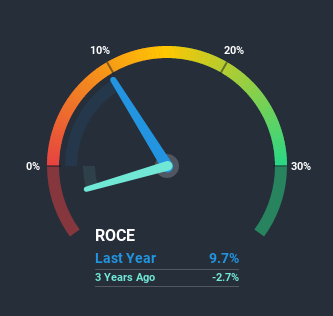Here’s What’s Happening With Returns At Gascoyne Resources (ASX:GCY)

If you're looking for a multi-bagger, there's a few things to keep an eye out for. Typically, we'll want to notice a trend of growing return on capital employed (ROCE) and alongside that, an expanding base of capital employed. Put simply, these types of businesses are compounding machines, meaning they are continually reinvesting their earnings at ever-higher rates of return. So on that note, Gascoyne Resources (ASX:GCY) looks quite promising in regards to its trends of return on capital.
Understanding Return On Capital Employed (ROCE)
If you haven't worked with ROCE before, it measures the 'return' (pre-tax profit) a company generates from capital employed in its business. To calculate this metric for Gascoyne Resources, this is the formula:
Return on Capital Employed = Earnings Before Interest and Tax (EBIT) ÷ (Total Assets - Current Liabilities)
0.097 = AU$9.1m ÷ (AU$237m - AU$143m) (Based on the trailing twelve months to June 2020).
Thus, Gascoyne Resources has an ROCE of 9.7%. On its own that's a low return on capital but it's in line with the industry's average returns of 9.6%.
See our latest analysis for Gascoyne Resources
Historical performance is a great place to start when researching a stock so above you can see the gauge for Gascoyne Resources' ROCE against it's prior returns. If you want to delve into the historical earnings, revenue and cash flow of Gascoyne Resources, check out these free graphs here.
How Are Returns Trending?
The fact that Gascoyne Resources is now generating some pre-tax profits from its prior investments is very encouraging. The company was generating losses five years ago, but now it's earning 9.7% which is a sight for sore eyes. In addition to that, Gascoyne Resources is employing 329% more capital than previously which is expected of a company that's trying to break into profitability. This can tell us that the company has plenty of reinvestment opportunities that are able to generate higher returns.
On a side note, we noticed that the improvement in ROCE appears to be partly fueled by an increase in current liabilities. Essentially the business now has suppliers or short-term creditors funding about 60% of its operations, which isn't ideal. Given it's pretty high ratio, we'd remind investors that having current liabilities at those levels can bring about some risks in certain businesses.
Our Take On Gascoyne Resources' ROCE
Long story short, we're delighted to see that Gascoyne Resources' reinvestment activities have paid off and the company is now profitable. Although the company may be facing some issues elsewhere since the stock has plunged 70% in the last five years. Still, it's worth doing some further research to see if the trends will continue into the future.
On a final note, we've found 2 warning signs for Gascoyne Resources that we think you should be aware of.
While Gascoyne Resources may not currently earn the highest returns, we've compiled a list of companies that currently earn more than 25% return on equity. Check out this free list here.
This article by Simply Wall St is general in nature. It does not constitute a recommendation to buy or sell any stock, and does not take account of your objectives, or your financial situation. We aim to bring you long-term focused analysis driven by fundamental data. Note that our analysis may not factor in the latest price-sensitive company announcements or qualitative material. Simply Wall St has no position in any stocks mentioned.
Have feedback on this article? Concerned about the content? Get in touch with us directly. Alternatively, email editorial-team@simplywallst.com.

